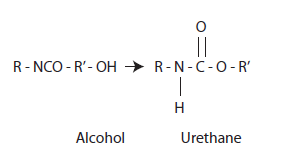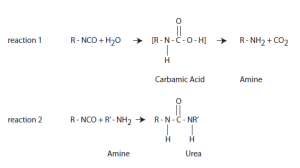One of the most versatile functional groups from the paint chemistry is the Isocyanate group.
R – N = C = O or R – NCO
During the late 1930’s, Otto Bayer and his co-workers pioneered the chemistry of polyisocyanates, a technology which led to the advert of polyurethanes for a variety of applications with special properties.
The isocyanate group can react with any compound containing a reactive hydrogen.
The main examples are: the H-atoms in alcohols, amines, amides, urea and water. In addition, isocyanate groups can react with itself.

I this article we concentrate on the reaction with water.
Polyurethane moisture curing coatings, cross-link under ambient conditions by reaction of isocyanates with atmospheric water. Most such coatings use isocyanate-terminated resins made from hydroxyl-terminated polyester by reacting the terminal hydroxyl groups with excess diisocyanate like oligomeric MDI or, if colour retention is needed, IPDI. So, the coating does not contain unreacted diisocyanate, the resin is prepared utilizing a ratio of N=C=O to OH that is significantly less than 2 to 1. The coatings are stable when stored in the absence of water, but cross-link after application by reaction with water to form amines, which react with another isocyanate to form substituted urea cross-links.

Cure rates depend on the water content of the air; at low temperatures, higher relative humidity is required than at higher temperatures, since the relative humidity decreases with increasing temperature. At high humidity and temperature, cure is rapid, but the carbon dioxide released by the reaction of isocyanate with water can be trapped as bubbles, especially in thick films. Moisture curing urethane coatings (MCU-Coatings) are formulated by Unica Special Coatings B.V. for corrosion/steel protection, for which abrasion resistance and hydrolytic stability are important. They are called urethane coatings even though these cross-links are urea rather than urethane groups. Since urea groups also form intermolecular hydrogen bonds, presumably, they can affect resistance to mechanical stress similarly to urethane groups. Hydrolytic resistance of coatings is affected by several variables, including cross-link density and free volume availability, as well as the functional groups present.
Productivity, Performance and Benefits
Moisture Curing Urethane paints are more and more used in new coating projects because of their long-term protection against corrosion, chemicals and superb colour- and gloss retention. Because of the wide variety of types available, designers and owners can use a package of systems including impregnating agents, primers, intermediate- and top coatings. Unica’s Moisture Curing Urethane paints offer cost and time savings by their excellent surface tolerance, drying speed, low usage (thin film technology), and the ability to be applied under most adverse weather conditions.
One of the great advantages of Moisture Curing Urethane paints is that they can be applied to steel surfaces with minimal surface preparation. Usually, cleaning with the help of hand/power tools is the only requirement for surface treatment. But blasting is and remains the best method, and also the most expensive. In comparison with blasting, is the amount of waste by cleaning with the help of hand/power tools drastically less, as well as the costs of the conditioning of the surface to be treated and costs of waste processing.
Unica’s Moisture Curing Urethane paints (MCU-Coatings) are designed with a wide range of physical properties, from soft and flexible to hard and stiff. In abrasion resistance tests (ASTM D 4060, Taber abrasion), loss of the coating is on average only about 10 to 30 milligrams. The impact resistance is also very impressive, up to 18 Nm (160 in.lbs) and stretch greater than 100 percent. Corrosion tests (salt spray acc. ISO 9227) are more than 3000 hours resistance. Cathodic disbonding tests (ISO 15711) passes 4200 hours, Seawater immersion (ISO 2812-2) passes 4200 hours.

